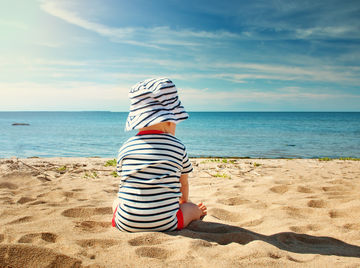This is a sponsored guest post.
When you’re taking your children to the beach for a fun family day, make sure they follow some swimming rules. Knowing where to swim, how to get help if they need it, and knowing what the warning flags mean can prevent injuries and keep a fun day from turning into a tragic day.
Adults should know them as well, so here are five beach swimming guidelines to follow.

Swim in Designated Areas
Beaches can be very busy with several activities going on all at the same time. If the beach you like to go permits surfing, boating tubing, and swimming, then there should be a designated area for swimmers.
By appointing a specific area, lifeguards don’t need to worry about swimmers getting hit by surfboards or boats. Show your kids where they’re allowed to swim, so they don’t get hurt.
Stay Close to Lifeguard Stations
At least one lifeguard station will be within the swimming area, so it is a good idea to stay within the vicinity when swimming in the ocean. Being near it will allow you, or one of your children, to get help quickly if needed.
Show them how to get the lifeguard’s attention when they’re in the water in case something happens, and they can’t swim to shore. When a USLA (United States Lifeguard Association) trained lifeguard is on duty, the chances of drowning are one in 18 million.
Obey All Signs
The beach will have warning signs if the water is not suitable for swimming. In some cases, they might close the beach. Read all signs that they post to ensure the water is safe for swimming. There could be dangers like pollution, jellyfish, or shark sightings.
Teach your kids what the safety flags at the lifeguard station mean as well. These flags give both swimmers and boaters information they need to stay safe. They can inform swimmers about water pest in the area, strong currents, and inclement weather.
Put on Sun Protection
Although it isn’t a rule, to protect your children’s skin, and your own, wear sunscreen. Most children will need to wear lotions between SPF 35 to SPF 50. Apply it about 10 to 15 minutes before they get out in the sun and reapply it after they’ve been in the water.
Did you know that the eyes can get sunburns too? Protect their eyes with swim goggles that have ultraviolet, UV, protection. The tag on the goggles should say if they have UV protection. To learn more about swim goggles, go to BeachRated.
Wear Floatation Devices
If you have beginning swimmers or small children going into the water, have them wear a floatation device. Water wings around their arms, a swimming vest, or a floatation swimsuit will keep them from accidentally going underwater.
By obeying these guidelines, you and your kids can stay safe when visiting the beach. Young children should be reminded of these rules and your rules every time you go to a beach outing. By repeating them, they will soon know them by heart and will know what to do in an emergency.




